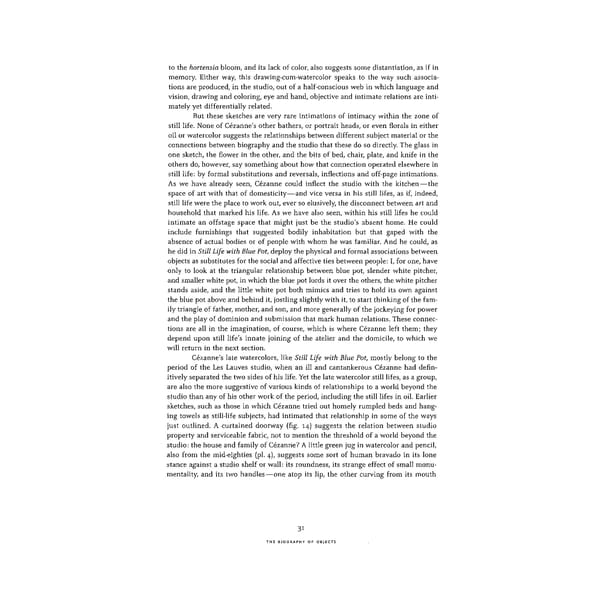to the hortensia bloom, and its lack of color, also suggests some distantiation, as if in memory. Either way, this drawing-cum-watercolor speaks to the way such associa- tions are produced, in the studio, out of a half-conscious web in which language and vision, drawing and coloring, eye and hand, objective and intimate relations are inti- mately yet differentially related. But these sketches are very rare intimations of intimacy within the zone of still life. None of Cezanne's other bathers, or portrait heads, or even florals in either oil or watercolor suggests the relationships between different subject material or the connections between biography and the studio that these do so directly. The glass in one sketch, the flower in the other, and the bits of bed, chair, plate, and knife in the others do, however, say something about how that connection operated elsewhere in still life: by formal substitutions and reversals, inflections and off-page intimations. As we have already seen, Cezanne could inflect the studio with the kitchen—the space of art with that of domesticity—and vice versa in his still lifes, as if, indeed, still life were the place to work out, ever so elusively, the disconnect between art and household that marked his life. As we have also seen, within his still lifes he could intimate an offstage space that might just be the studio's absent home. He could include furnishings that suggested bodily inhabitation but that gaped with the absence of actual bodies or of people with whom he was familiar. And he could, as he did in Still Life with Blue Pot, deploy the physical and formal associations between objects as substitutes for the social and affective ties between people: I, for one, have only to look at the triangular relationship between blue pot, slender white pitcher, and smaller white pot, in which the blue pot lords it over the others, the white pitcher stands aside, and the little white pot both mimics and tries to hold its own against the blue pot above and behind it, jostling slightly with it, to start thinking of the fam- ily triangle of father, mother, and son, and more generally of the jockeying for power and the play of dominion and submission that mark human relations. These connec- tions are all in the imagination, of course, which is where Cezanne left them; they depend upon still life's innate joining of the atelier and the domicile, to which we will return in the next section. Cezanne's late watercolors, like Still Life with Blue Pot, mostly belong to the period of the Les Lauves studio, when an ill and cantankerous Cezanne had defin- itively separated the two sides of his life. Yet the late watercolor still lifes, as a group, are also the more suggestive of various kinds of relationships to a world beyond the studio than any of his other work of the period, including the still lifes in oil. Earlier sketches, such as those in which Cezanne tried out homely rumpled beds and hang- ing towels as still-life subjects, had intimated that relationship in some of the ways just outlined. A curtained doorway (fig. 14) suggests the relation between studio property and serviceable fabric, not to mention the threshold of a world beyond the studio: the house and family of Cezanne? A little green jug in watercolor and pencil, also from the mid-eighties (pi. 4), suggests some sort of human bravado in its lone stance against a studio shelf or wall: its roundness, its strange effect of small monu- mentality, and its two handles—one atop its lip, the other curving from its mouth 31 THE BIOGRAPHY OF OBJECTS
 Cézanne in the Studio: Still Life in Watercolors Page 45 Page 47
Cézanne in the Studio: Still Life in Watercolors Page 45 Page 47